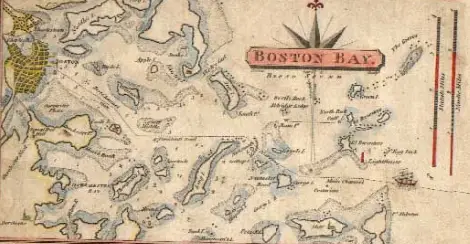In July of 1726, William Fry stood trial in Boston for murdering a ship’s captain and embarking on a monthlong piracy spree. The trial lasted but two days, and Fry was convicted. Within days, he would be paraded to the gallows and hanged.
But he didn’t go as most did, remorseful and tearful. Rather, when the cart arrived to haul him off, he jumped up and enjoyed the parade, waving flowers in one hand. When asked for his final words, he sought no forgiveness. Rather, he warned other ship captains to treat their crews well if they wanted to avoid being killed at sea.
And as the hangman dropped a poorly made noose over his head, Fry scoffed at the man. He informed him: ‘You do not know your trade.” Fry adjusted the noose and slipped it into place before dropping to his death.
The flamboyant Fry’s body would soon hang on Nixes Mate, a small island in Outer Boston Harbor near Long Island. It serves as a navigational aid to sailors.
William Fry
Fry’s story elicited tremendous public interest, as did all cases involving pirates. The prolific minister Cotton Mather had tried desperately to coax a confession and repentance from Fry. Mather took pride in his reputation as a minister who could convert hardened criminals to religion as they headed to the gallows.
Crowds attended the sermons he preached at hangings, where he tried to serve up a cautionary tale for young people. He would often furnish the condemned men with prayers to recite as they went to the gallows.
In Fry, however, he met his match. Fry had a history as a boxer in Jamaica. Though he had sailed with pirates before, he signed on the Elizabeth Snow as a legitimate boatswain. It’s not precisely clear what caused him to turn pirate and lead a mutiny, but he spelled out the facts at trial.

Nixes Mate
Fry and two other men seized control of the ship. They offered the captain a chance to jump overboard, but he pleaded for his life. So Fry and his compatriots shoved him over. As the struggling captain grabbed at a line to save himself, one of the attackers cleaved off his hand with an ax, sending him to his death.
The mate fared no better. When he fought for his life, he was struck with the ax across the shoulder and sent tumbling into the sea.
Poor Pirate
Fry turned into a remarkably poor pirate. After seizing the Elizabeth Snow in May, he attempted to seize another vessel, but ran it aground off North Carolina. He seized a second vessel, but the pilot on board outsmarted him. The pilot deliberately sailed past Martha’s Vineyard, claiming he didn’t know his location. Then, as the vessel neared Boston, he overpowered Fry and with the help of other captives sailed the ship into Boston Harbor. That set Fry’s appointment with the noose.

Cotton Mather
Fry’s standoff with Cotton Mather was equally fruitless. Though Fry never buckled on the gallows, Mather publicized his case in a pamphlet and made him look every bit a dunce. Though Fry insisted he had suffered “bad usage” at the hands of the Elizabeth Snow’s captain, Mather never publicized his complaints. Some historians have noted that the vessel was a slave ship, and the captains of such ships were often ruthless with their crew. Others note that many sailors who turned pirate were impressed into service, inspiring their decision to step outside the law.
Regardless, Mather had his own uses for Fry’s story. He used it to highlight the end that comes to depraved, wicked and stupid people. The town officials had an even more gruesome use for the pirate. Gibbeting was the practice of stringing up a corpse and hanging it in the harbor as a warning to other would-be pirates. And that’s exactly what happened to Fry, on the island of Nixes Mate. (Then called Nick’s Mate.) His bones rattled in the winds for many months.

Display at the Maritime Museum of the Atlantic. Replica of Edward Jordan’s gibbet.
Nixes Mate
The island itself, now part of the Boston Harbor Islands owned by the National Park Service, has a curious history. Granted to harbor pilot John Gallop in 1636, he used it for grazing sheep. At that time it was reported to be 12 acres in area. Over time, however, the island has been reduced dramatically in size to its present area of about 200-square feet. Upon which stands a granite base and a wooden pyramid that acts as daymarker for sailors trying to navigate into the harbor.
Legend says the island was named for a Captain Nix or Nick, murdered by his first mate. The mate was tried and hanged on the island. In his final words, he protested his innocence. If he was hanged, he warned, the island would sink into the sea as testament to the wrong done to him.
The island did disappear after his hanging.
But a better explanation for the island’s disappearance: People quarried the island for rocks used as ballast in sailing ships.
The actual origin of the name remains lost.
This story last updated in 2022.
Images: Nixes Mate By Eric Kilby from Somerville, MA, USA – Nixes Mate, CC BY-SA 2.0, https://commons.wikimedia.org/w/index.php?curid=44427125. Gibbeted pirate By Dennis Jarvis from Halifax, Canada – DSC07278 – Gibbet, CC BY-SA 2.0, https://commons.wikimedia.org/w/index.php?curid=66916336.

